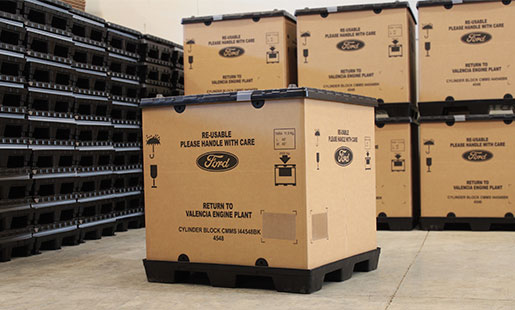Optimal Security: Industrial Packaging Solutions Tailored for Success
Optimal Security: Industrial Packaging Solutions Tailored for Success
Blog Article
Efficient Industrial Recycling Solutions for Lasting Product Packaging: A Comprehensive Guide
That's where this thorough overview on effective commercial recycling options for sustainable product packaging comes in. By checking out key locations such as packaging product choice, designing for recyclability, applying reusing infrastructure, teaming up with recycling companions, and monitoring and measuring reusing success, this guide will certainly equip you with the expertise and tools essential to make informed decisions and drive positive adjustment within your organization. Whether you're a packaging specialist, sustainability manager, or merely interested in the subject, this guide will offer valuable insights and approaches to aid you navigate the globe of sustainable product packaging.
Product Packaging Product Choice
The option of product packaging materials plays a vital duty in ensuring the sustainability of industrial recycling services. The choice of materials is key in minimizing ecological influence and maximizing recycling performance when it comes to lasting product packaging. Choosing the ideal products can help in reducing waste generation, save resources, and promote a round economy.
Products like cardboard, paper, glass, and specific kinds of plastics can be recycled numerous times without losing their top quality. On the other hand, products that are challenging to reuse, such as non-recyclable composites or blended plastics, can create difficulties for the reusing process and may finish up in landfills or incinerators.
Another factor to consider is making use of eco-friendly and eco-friendly products. Product packaging made from sustainable sources, such as plant-based plastics or biopolymers, can help in reducing dependency on fossil fuels and minimize climate modification. In addition, biodegradable materials damage down normally over time, lowering the accumulation of waste in garbage dumps.
Furthermore, the weight and volume of product packaging products should be reduced to minimize transport costs and energy usage. Lightweight products not just require fewer sources throughout production but likewise contribute to lower carbon discharges throughout transport.
Creating for Recyclability
In order to ensure the recyclability of packaging materials, thoughtful design is necessary. Creating for recyclability entails developing product packaging that can be conveniently sorted, separated, and processed in recycling facilities. One important aspect of developing for recyclability is the option of materials. Packaging designers should prioritize using products that are extensively approved for reusing and have actually established recycling frameworks. Products such as glass, light weight aluminum, and particular sorts of plastic, like family pet and HDPE, are frequently reused and ought to be chosen over materials that are costly or hard to recycle.
Another essential factor to consider in creating for recyclability is the elimination of unneeded elements or products. By minimizing the number of layers, layers, and extra components, product packaging can be made easier and simpler to reuse. Additionally, developers need to aim to minimize using combined products, as they can complicate the reusing process.

Implementing Recycling Framework
Effective application of reusing facilities is crucial for the success of industrial reusing services. Without correct infrastructure in position, the reusing process ends up being ineffective and inefficient, impeding the total goal of sustainable product packaging.
To implement recycling facilities effectively, numerous essential variables need to be considered. There need to be a well-organized collection system that helps with the separation and collection of recyclable products. This can include designated reusing containers in public rooms, as well as partnerships with waste management companies for curbside pick-up and sorting.
When accumulated, the recyclable products require to be transferred to reusing centers in a timely manner. This needs reliable logistics and transportation networks, making certain that the materials reach the appropriate centers without delay.
At the recycling centers, progressed sorting and processing innovations should be in place to divide various types of products effectively. This consists of making use of automated arranging equipments, optical scanners, and hands-on sorting techniques.
Additionally, there should be a durable market demand for recycled products. This can be attained through cooperations with makers and sectors that use recycled products in their manufacturing procedures. Developing a steady market for recycled products incentivizes the recycling market and advertises the circular economic situation.
Working Together With Recycling Partners

One key facet of working together with recycling companions is the facility of clear communication networks. It is crucial to develop open lines of interaction to facilitate the exchange of details, updates, and feedback. This permits both parties to remain informed about the development of reusing initiatives and deal with any kind of obstacles or problems that may develop.
In addition, collaboration can involve collaborations in executing and developing recycling programs. Reusing partners can supply beneficial insights and advice in establishing efficient collection systems and figuring out the most suitable recycling modern technologies. By collaborating, companies and reusing companions can enhance the recycling procedure and minimize waste.
Furthermore, cooperation can prolong past the functional facets of recycling. It can additionally encompass campaigning for and education and learning initiatives. By joining pressures, businesses and recycling companions can elevate awareness about the relevance of recycling and promote the adoption of lasting product packaging practices amongst customers and various other stakeholders.
Tracking and Measuring Recycling Success
To guarantee the efficiency of industrial recycling options and the success of lasting packaging goals, it is essential for services and their reusing companions to develop a thorough system for tracking and gauging reusing success (processing company). Determining and tracking reusing success enables companies to examine the influence of their recycling initiatives, recognize areas for enhancement, and set significant targets for future development
One means to track recycling success is with the use of data collection and analysis tools. By gathering information on the amount of packaging waste generated, the percentage of waste that is reused, and the types of products being recycled, companies can acquire important insights into their reusing efficiency. This information can then be evaluated to identify patterns, patterns, and areas of inefficiency.
Another crucial element directory of monitoring and determining recycling success is developing standardized and clear metrics. This permits organizations to compare their efficiency against market criteria and track their progress with time. Metrics such as reusing rates, waste diversion rates, and greenhouse gas exhausts can supply a quantitative measure of a business's reusing success.

Verdict
To conclude, applying efficient industrial recycling remedies for lasting packaging calls for careful consideration of product packaging product option, developing for recyclability, carrying out recycling framework, working together with reusing companions, and tracking and measuring reusing success. By incorporating these methods, services can contribute to an extra environmentally-friendly and sustainable technique to packaging, minimizing waste and promoting the circular economic situation.
By checking out vital areas such as product packaging material selection, making for recyclability, executing reusing infrastructure, working together with reusing companions, and tracking and determining reusing success, this guide will outfit you with the knowledge and devices necessary to make educated choices and drive favorable adjustment within your company. Packaging developers need to prioritize the use of products that are commonly accepted for recycling and have developed reusing infrastructures.Cooperation with recycling partners is crucial for the successful implementation of commercial reusing solutions and the accomplishment of lasting product packaging objectives. By signing up with forces, organizations and recycling partners can increase understanding regarding the relevance of recycling and promote the fostering of lasting product packaging techniques amongst consumers and various other stakeholders.
By accumulating information on the quantity of product packaging waste created, the percentage of waste that is reused, and the kinds of products being reused, organizations can gain important understandings right into their reusing efficiency.
Report this page